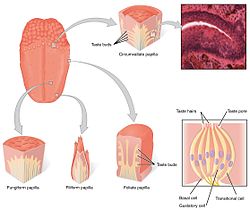
Back مستقبل ذوقي Arabic Receptor del gust Catalan Chuťový receptor Czech Receptor de gusto Spanish گیرنده چشایی Persian Récepteur gustatif French Receptor de sabor Portuguese Receptor ukusa Serbo-Croatian Receptor ukusa Serbian หน่วยรับรส Thai
| Taste receptor | |
|---|---|
 Taste receptors of the tongue are present in the taste buds of papillae. | |
| Identifiers | |
| FMA | 84662 |
| Anatomical terminology | |
A taste receptor or tastant is a type of cellular receptor which facilitates the sensation of taste. When food or other substances enter the mouth, molecules interact with saliva and are bound to taste receptors in the oral cavity and other locations. Molecules which give a sensation of taste are considered "sapid".[1]
Vertebrate taste receptors are divided into two families:[citation needed]
- Type 1, sweet, first characterized in 2001:[2] TAS1R2 – TAS1R3
- Type 2, bitter, first characterized in 2000:[3] In humans there are 25 known different bitter receptors, in cats there are 12, in chickens there are three, and in mice there are 35 known different bitter receptors.[4]
Visual, olfactive, "sapictive" (the perception of tastes), trigeminal (hot, cool), mechanical, all contribute to the perception of taste. Of these, transient receptor potential cation channel subfamily V member 1 (TRPV1) vanilloid receptors are responsible for the perception of heat from some molecules such as capsaicin, and a CMR1 receptor is responsible for the perception of cold from molecules such as menthol, eucalyptol, and icilin.[1]
- ^ a b This, Hervé (2012). "The Science of the Oven - Excerpt from Chapter 1". Archived from the original on 2 May 2014. Retrieved 30 Apr 2014.
- ^ Nelson G, Hoon MA, Chandrashekar J, et al. (August 2001). "Mammalian sweet taste receptors". Cell. 106 (3): 381–90. doi:10.1016/S0092-8674(01)00451-2. PMID 11509186. S2CID 11886074.
- ^ Adler E, Hoon MA, Mueller KL, et al. (March 2000). "A novel family of mammalian taste receptors". Cell. 100 (6): 693–702. doi:10.1016/S0092-8674(00)80705-9. PMID 10761934. S2CID 14604586.
- ^ "Browse Receptors". Bitter DB.
© MMXXIII Rich X Search. We shall prevail. All rights reserved. Rich X Search